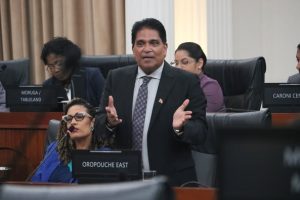By Ravi Nanga
CONTINUING our examination of the labour laws, we examined the principles that are applied to a trade dispute in the Industrial Court.
In our first article we came across the concept of a “worker” and last week we saw the term “Collective Agreement”.
This week we examine these two terms in some more detail.
Under the Industrial Relations Act there is a definition of who is a worker. In the event an employer decides to argue that an employee who is challenging the disciplinary process is not a worker within the meaning of the act, ideally the employer should make such a submission when the union reports the existence of a dispute to the Ministry of Labour and Small Enterprise Development.
In the event the employer argues that the employee is not a worker within the meaning of the act, the minister will then refer that question to the body known as the Registration Recognition and Certification Board, commonly referred to as the RRCB.
The RRCB is established under the Industrial Relations Act and the act prescribes the powers and functions of the RRCB. In the event the employer is unable to argue that the employee is not a worker at the ministry, once the Industrial Court is satisfied that the employer did not have a proper opportunity to make such an argument there, the court can also refer the question to the RRCB.
Upon receipt of the query, either from the minister or the court, the RRCB will invite the employer and the union to file arguments as to why the employer is maintaining that the employee is not a worker and why the union is maintaining that the employee is a worker.
Thereafter, the RRCB will have a clarification hearing, where the parties will be allowed to make submissions in support of their respective positions. Following the clarification hearing, the person chairing the clarification meeting will prepare a report and forward all the documents to the RRCB in order for the board to determine the question of whether the employer is a worker or not. The RRCB is the sole body that determine such a question.
In the event the RRCB decides that the employee is not a worker within the meaning of the act, that is the end of the trade dispute and the trade dispute will be dismissed. If the RRCB decides that the employee is a worker, then the trade dispute will continue, either before the ministry or the court, depending from where the question was referred.
Synonymous with the term “Collective Agreement” is the term “Recognized Majority Union”. In any place of employment, it is open to a trade union to apply to the RRCB for recognition as the Recognized Majority Trade Union of that place of employment. Once a union receives such recognition, the employer is legally obligated to meet and treat with the Recognized Majority Union. Again, the Industrial Relations Act provides the benefits of recognition and the obligations of the parties. If there is a Recognized Majority Union, it is an Industrial Relations Offence for an employer to refuse to meet and treat with the Union.
One of the instances in which the employer and the Recognized Majority Union are expected to meet and treat and collaborate is in negotiating and agreeing to the terms of a collective agreement.
The Collective Agreement is a document that contains the terms and conditions of employment in respect of the employees who form the bargaining unit. The bargaining unit is that group of workers who the Recognized Majority Union represents. The employer and the union will meet and negotiate towards agreeing to the terms of the collective agreement. Collective agreements are comprehensive documents that define the rights and benefits of the employer and the employee.
For example, the collective agreement can recognise the employer’s right to make management decisions in the interest of the business, and will contain provisions in respect of the rate of pay, entitlement to vacation, entitlement to a pension and disciplinary procedures, among other provisions.
Once agreement on the terms of a collective agreement is arrived at, the collective agreement must be registered at the Industrial Court. In the event the employer and the union are unable to arrive at agreement on all the terms of the collective agreement, that will be regarded as a break down in negotiations and can be referred to the ministry as a trade dispute. Once the normal procedure is followed, the dispute can reach the doors of the Industrial Court, who can then determine the dispute and assist the parties in finalizing the terms that are unable to be agreed upon.
Having addressed this topic for the past three weeks, it is easy to recognise that labour law is not a simple or easy topic, as it is filled with many different and intricate principles.
In the event you are of the view that you have been aggrieved at your place of employment, it is advisable that you seek the advice of an attorney-at-law, so that you will be able to get full and proper advice in order to protect your rights.
Ravi Nanga is an attorney-at-law.
(Please note that this article is intended only to provide general information on the topic being addressed and should not be taken as providing legal advice. In order to be properly advised it will be necessary for an attorney to examine the relevant documents and obtain the necessary instructions before properly advising as to rights and obligations).
See other articles by Ravi Nanga:
![]()













